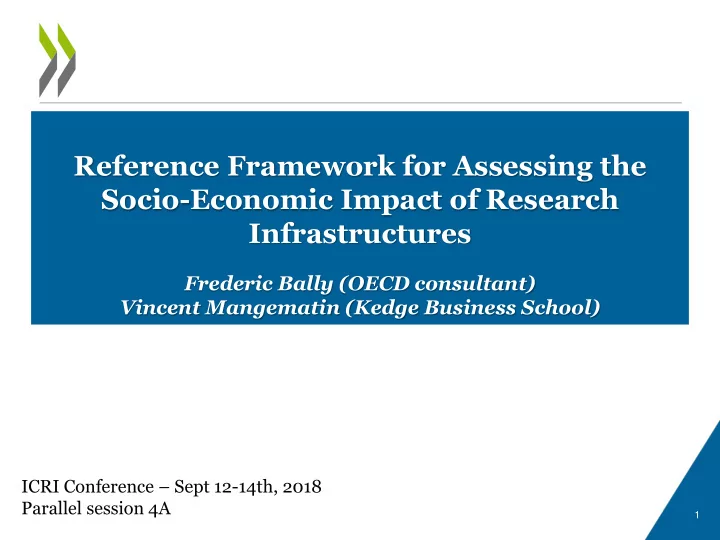

Reference Framework for Assessing the Socio-Economic Impact of Research Infrastructures Frederic Bally (OECD consultant) Vincent Mangematin (Kedge Business School) ICRI Conference – Sept 12-14th, 2018 Parallel session 4A 1
Agenda Introduction Philosophy and positioning The forthcoming OECD framework Importance of SEI How to Assess Missions SEI is not all impact Discussions (see paper) How to use SEIRI 2
Philosophy and positioning The philosophy of the framework : harmonize the assessment methodology and reduce the workload of RI managers by standardizing socio-economic impact indicators and by defining a set of common Core Impact Indicators (CII) Indicators designed with and for RI managers to monitor part of their activities: Socio-economic impact Coupling strategy, stakeholders’ demands and RI’s vision, mission and priorities A general and modular framework, not “one size fits all” A set of standardized indicators + ad hoc indicators to accommodate the specificity of each RI 3
Why is socio-economic impact so important? Meeting the societal Growing role of challenges with science in the enabling scientific society infrastructures Coslty investment Ex ante to help the from multiple management stakeholders decision process 4
Why is socio-economic impact so important? Exploring the so what questions From results to scientific contribution – (science) From results to wealth creation (innovation, patent, device, …) From results to societal challenges (policy, society) Articulate ex ante the relationship between science, economy and the society 5
How to assess socio-economic impact? Long term commitment From KPIs to CIIs (longitudinal process) Impacting through the Ex ante: Inform the ESS activities – decision making different dimensions process and practices of impact and different stakeholders 6
How to assess socio-economic impact? Meeting the societal challenges in different ways : assessment based on the objectives of the RI Construction of metrics to evaluate the trends Stories to make sense and to exemplify 7
Our socio-economic impact model Inputs Activities Outcomes Impacts • Fundings • Scientific • Job creation • Economic growth • Co-investment • Training • Better science • Innovation for society • Other resources • Industrial • Promoting collaborations • Social capital • Outreach (public) • Knowledge • Increase transfer innovative performance • More tax payers (region) 8
Identifying the mission and objectives of RIs Be the national, continental or world scientific leading RI Be an enabling facility to support Science & Technology Become integrated in a regional cluster/in regional strategies / Be the hub to facilitate regional collaborations Promote education outreach and knowledge transfer Provide scientific support to public policies Date policy, production and use Assume social responsibility towards society Additional strategic objectives were mentioned by a few respondents such as Promote international relationships and global diplomacy through science collaborations (“Science diplomacy”). 9
Example of core impact indicators Objective: World-Class RI Enabling Scientific Breakthroughs and Addressing Grand Societal Challenges Scientific performances (Publications, citations, patents, etc.) Grand Socio-Economic Impact (local, regional, European and global) related to grand challenges (health, climate change etc.) Scientific Breakthrough (Science for Society) Visibility. / Attractiveness for Public Objective: Promote education outreach and knowledge transfer Impacts on human resource capacity (Number of students trained within the R; Nber of Conferences and seminars within the RI and outside; Nber of people engaged in RI for educational & outreach activities (open days and other events)- Total number of participants RI attractiveness and inspiration for the public - Total number of educational and outreach activities- (Occurrence of the RI in online media (press), local and regional. Consultation of the website (number of visitors on the website) 10
How to use the framework First approach : by objectives or missions Second approach : by list of indicators (science, technology, direct and indirect economic impact, etc.) Standardized list of indicators To be accountable to the stakeholders Monitor the socio-economic achievements of Socio-economic impacts (move beyond only scientific impacts) Articulate objectives, socio-economic impacts and monitoring One size does not fit all Modularity of impact indictors by combining existing and standardized indicators Different objectives and impacts 11
Thank you very much for attention Comments and questions welcome 12
Definitions Continental : refers to one of the large “world regions” (e.g. Europe, North America, etc.) Core impact indicators : limited set of impact indicators which could be used within a scoreboard by RI management. Data : Indicators rely on data collection. Data informs the indicator about the level of achievement. Impact : Mid- to long term changes attributable to an activity (e.g. general quality and visibility of local research). Indicator : Indicators are elements related to an activity. Good indicators are valid (reflecting properly what is being measured), reliable, and usable (easy to collect, non-ambiguous). Key Performance Indicators : KPI are dedicated to monitor the process and its efficiency in delivering the outcome, by measuring effectiveness and performance. Local : Immediate geographical area around the RI. Mission of the RI : The mission refers to the raison d’être of the RI, its services and products delivered and the communities of users it serves. It is usually described in the statutes of the organisation. It is sometimes understood as strategic objectives. Output : Good and / or service produced / delivered by the activity (e.g. RI services to the scientific community). Worldwide scientific leading teams : teams or groups of researchers whose excellence is internationnaly recognised. They are often identified by their publications in leading (Q1) scientific journals. 13
Recommend
More recommend